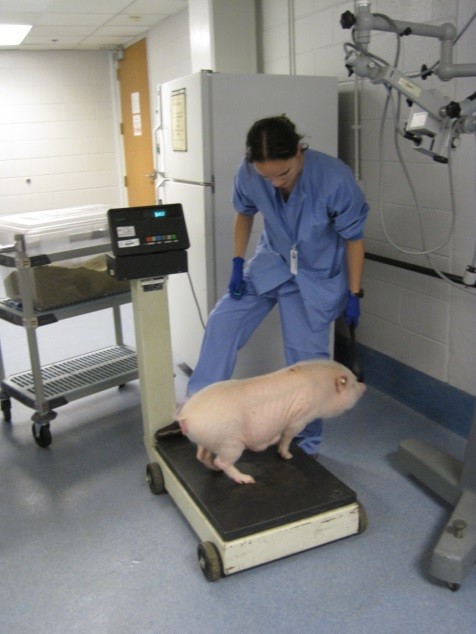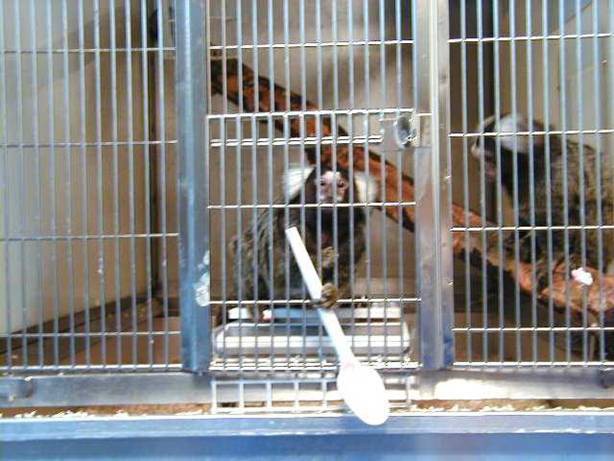Training animals
Guidance on implementing positive reinforcement training methods.
On this page
Introduction
Positive reinforcement training methods which reward desired behaviour, have become a valuable tool for the humane care and use of laboratory animals. Positive reinforcement training is based on providing a pleasant action or event to an animal, immediately after the animal shows the behaviour that the trainer wants to increase in frequency. Positive reinforcement training (PRT) is a refinement in animal handling methods that can improve animal welfare, animal husbandry, veterinary care, and the value of animals as research subjects. Accordingly, animal training is recommended as good practice by legislative and professional guidelines on laboratory animal care, and is an important element of comprehensive behavioural management programmes. Maintaining personnel safety is essential as these programmes are implemented.
Watch our welfare webinar on socialisation and positive reinforcement training for pigs and dogs for practical examples of how positive reinforcement techniques can be applied in a research environment.
Animal welfare benefits of positive reinforcement training
The principles of positive reinforcement training apply across animal species, and non-human primates, dogs, cats, pigs, rodents, farm species, birds and others can benefit from this type of training (See Photos 1, 2 and 3). With an entirely positive reinforcement approach, if the animal chooses not to participate, s/he is not coerced into participating and there is no negative consequence to the animal. In this way the animal can exercise choice, and has increased control over his or her environment; choice and control are considered to be important means of promoting the welfare of captive animals. In PRT the pace of the training is dictated by the animal, and this seems to reduce the stress they experience, as indicated by their behaviour and by a variety of physiological measures (e.g., stress hormones such as corticosteriods, total white blood cell counts, glucose levels). PRT reduces the need for physical restraint and/or the use of anaesthesia, as well as the risks associated with those events. One training technique called counter conditioning or desensitization, can be used to reduce the animal’s fear of equipment, husbandry procedures, people, and other things, so that the animal becomes more comfortable in the research setting.
In addition to benefiting animal welfare, PRT can also enhance the quality of research by minimizing individual physiological changes (such as those associated with stress or fear) that are likely to increase variability in experimental data. Techniques that reduce sources of variability also have the potential to reduce the number of animals required in a given research project.


Training laboratory primates
PRT programmes have been most fully developed and evaluated for laboratory primates, but similar advances are being accomplished with many other animals. Through PRT, primates have been taught to move into transfer boxes when asked, or from one enclosure to another, to allow careful examination of body parts (e.g., inside the mouth, hands, chest), to allow use of a stethoscope to listen to their heart or lungs, and to present the perineum area for parasite testing. Primates have cooperated with diagnostic radiograph procedures, with acupuncture treatments, and with having wounds closely examined and treated with topical medications. Training primates to calmly tolerate restraint (e.g., sitting in a “restraint chair”) can reduce their stress and increase the ease of conducting certain research studies. Many different biological samples can be collected from cooperating primates including urine, feces, saliva, vaginal fluids, semen, nasal fluids, and even blood. Primates have also been trained to allow intramuscular and subcutaneous injections. In some cases training can reduce abnormal behavioural patterns such as pacing, especially if the animals are trained to engage in behaviours that are incompatible with the expression of the abnormal behaviour. Other applications of PRT can reduce aggression within social groups (by using training to reducing competition over food, for example) and reduce aggression toward humans. Experience has shown that trained animals maintain a high degree of reliability in participation, but if they regress (their performance of a previously trained behaviour has worsened) further training can generally re-establish the behaviour.

Costs of training
The principle cost associated with training is the initial time investment involved with educating staff, and with implementing the behaviour modification process. In some cases this cost can be recouped later since training can increase the ease, speed and safety with which procedures can be performed. Another way of reducing the cost of training that is now being studied, is identifying individual differences in animal characteristics (such as personality or temperament), that may predict more rapid acquisition of the behaviours to be trained, and then matching selected animals with particular research procedures to be trained.
Negative reinforcement
In some situations, using PRT requires more training time than the use of more traditional training methods that depend primarily on negative reinforcement. Negative reinforcement (NR) relies on removing an unpleasant action or aversive stimulus immediately after the desired behaviour occurs. A common negative reinforcement method in the laboratory is using a cage “squeeze back” to move an animal into position for a procedure, and then releasing the squeeze back as soon as the needed behaviour is performed. This type of training is effective, but is less desirable because it reduces the animals’ choice and control, and may involve coercion. When PRT cannot practically accomplish what is needed in a reasonable timeframe, it is possible to use NR in conjunction with PRT to speed up the training process. In these cases, the minimal magnitude of NR should be used to achieve the goal, it should be used for as short a time as possible, and it should be used along with PRT. In some situations, it is possible to use a brief application of NR to facilitate progress at certain points in training, while still using PRT for the majority of the training steps.
Guidance on positive reinforcement training
The growing body of scientific literature describing and evaluating animal training methods should be carefully reviewed by those who are trying to discern the value of PRT for their own animal management programmes. There is some guidance available to help laboratory personnel develop and implement appropriate training programmes (see Related resources), in particular for non-human primates and dogs.The NC3Rs is active in developing further guidance on training of non-human primates, including guidance on refining the use of food or fluid control as motivational tools for macaques used in behavioural neuroscience and training for cooperation with chair restraint (see our resource pages on non-human primates).
Related resources
General information on laboratory animal training techniques:
- Berns GS, Brooks AM, Spivak M (2012). Functional MRI in awake unrestrained dogs. PLOS ONE 7, 1-7.
- Schapiro, SJ, Bloomsmith MA, Laule GE (2003). Positive reinforcement training as a technique to alter nonhuman primate behavior: quantitative assessments of effectiveness. Journal of Applied Animal Welfare Science, 6(3), 175-188.
Establishing animal training programmes:
- Prescott MJ, Bowell VA, Buchanan-Smith HM (2005). Training of laboratory-housed non-human primates, part 2: Resources for developing and implementing training programmes. Animal Technology and Welfare 4, 133-148.
- Prescott MJ, Buchanan-Smith HM (2007). Training laboratory-housed non-human primates, part I: A UK survey. Anim. Welfare 16, 21-36.
- Perlman JE, Bloomsmith MA, Whittaker MA, et al. (2012). Implementing positive reinforcement animal training programs at primate laboratories. Applied Animal Behaviour Science 137(3-4), 114-126.
Training for biological sample collection:
- Coleman KL, Pranger L, Maier A et al. (2008). Training rhesus macaques for venipuncture using positive reinforcement training techniques: A comparison with chimpanzees. J. Am. Assoc. Lab. Anim. Sci. 47, 37-41.
- Laule GE, Thurston RH, Alford PL, Bloomsmith MA (1996). Training to reliably obtain blood and urine samples from a young diabetic chimpanzee (Pan troglodytes). Zoo Biol. 15, 587-591.
Methods to improve training efficiency:
- Coleman K, Tully LA, McMillan JL (2005). Temperament correlates with training success in adult rhesus macaques. Am. J. Primatol. 65, 63-71.
- ernstrom AL, Fredlund H, Spangberg M, Westlund K (2009). Positive reinforcement training in rhesus macaques – training progress as a result of training frequency. Am. J. Primatol. 71, 373-379.
Effects of training on physiological variables:
- Lambeth SP, Hau J, Perlman JE, Martino M, Schapiro SJ (2006). Positive reinforcement training affects hematologic and serum chemistry values in captive chimpanzees (Pan troglodytes). Am. J. Primatol. 68, 245-256.
Training to tolerate restraint:
- McMillan JL, Perlman JE, Galvan A, Bloomsmith MA, Wichmann T (2014). Refining the pole and collar method of restraint: Emphasizing the use of positive training techniques with rhesus macaques. Journal of the American Association for Laboratory Animal Science 53, 61-68.
Using desensitisation to reduce fear and aggression in primates:
- Clay AW, Bloomsmith MA, Marr MJ, Maple TL (2009). Habituation and desensitization as methods for reducing fearful behavior in singly-housed rhesus macaques. American Journal of Primatology, 71(1), 30-39.
- Minier DE, Tatum L, Gottlieb DH, Cameron A, McCowan B (2011). Human-directed contra-aggression training using positive reinforcement with single and multiple trainers for indoor-housed rhesus macaques. J. Appl. Anim. Behav. Sci. 132, 3–4, 178-186.
Training primates and time savings:
- Veeder CL, Bloomsmith MA, McMillan JL, Perlman JE, Martin A (2009). Positive reinforcement training to enhance the voluntary movement of group-housed sooty mangabeys (cercocebus atys atys). Journal of the American Association for Laboratory Animal Science, 48(2), 192-195.
- McKinley J, Buchanan-Smith H, Bassett L (2003). Training common marmosets (Callithrix jacchus) to cooperate during routine laboratory procedures: Ease of training and time investment. Journal of Applied Animal Welfare Science. 6, 209-220.
Positive reinforcement training to improve group dynamics:
- Bloomsmith MA, Laule GE, Alford PL, Thruston RH (1994). Using training to moderate chimpanzee aggression during feedings. Zoo Biology, 13(1), 557-566.
- Schapiro SJ, Perlman JE, Boudreau B (2001). Manipulating the affiliative interactions of group-housed rhesus macaques using positive reinforcement training techniques. Am. J. Primatol. 55, 137-149.
Training as a treatment for abnormal or undesirable behaviour:
- Bourgeois SR, Brent L (2005). Modifying the behaviour of singly caged baboons: Evaluating the effectiveness of four enrichment techniques. Animal Welfare, 14, 71-81.
- Martin AL, Bloomsmith MA, Kelley ME, Marr MJ, Maple TL (2011). Functional analysis and treatment of human-directed undesirable behavior exhibited by a captive chimpanzee. Journal of Applied Behavior Analysis, 44, 139-143.
- Coleman K, Maier A, (2010). The use of positive reinforcement training to reduce stereotypic behavior in rhesus macaques. Appl. Anim. Behav. Sci. 124, 142-148.
